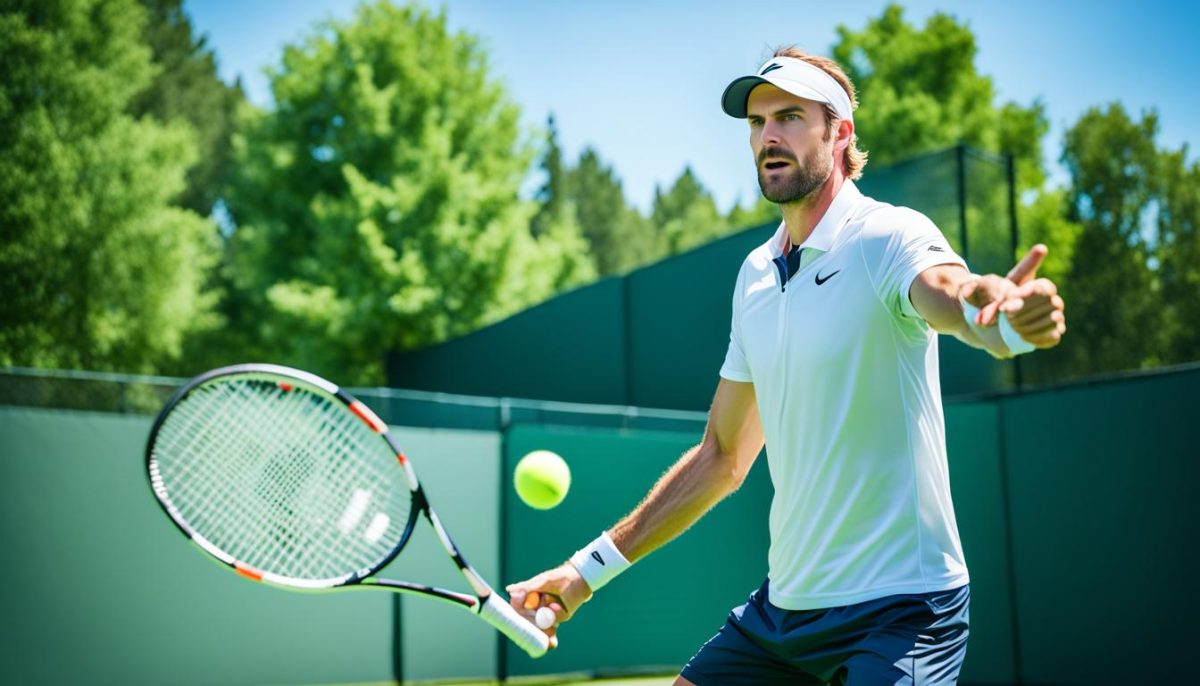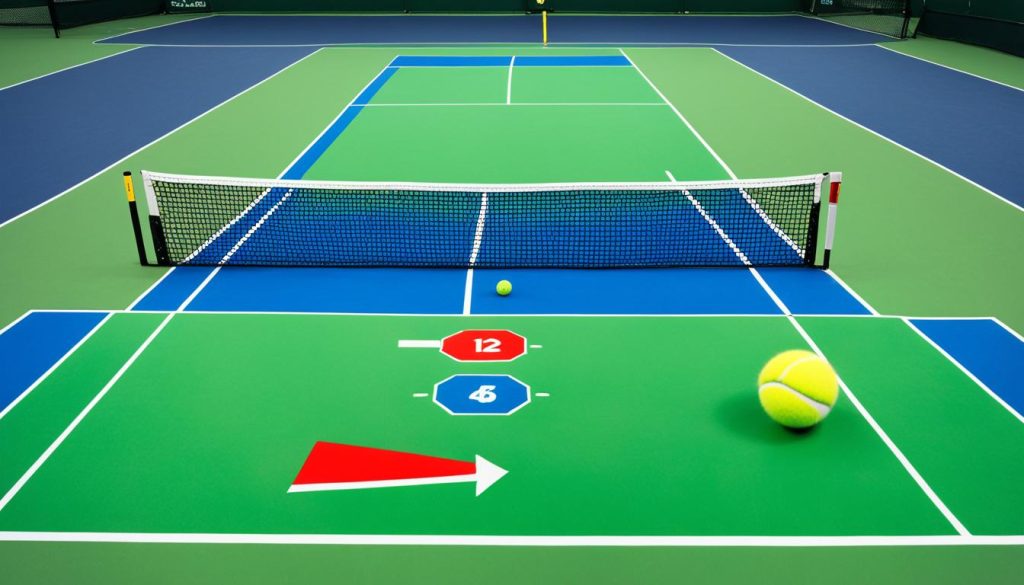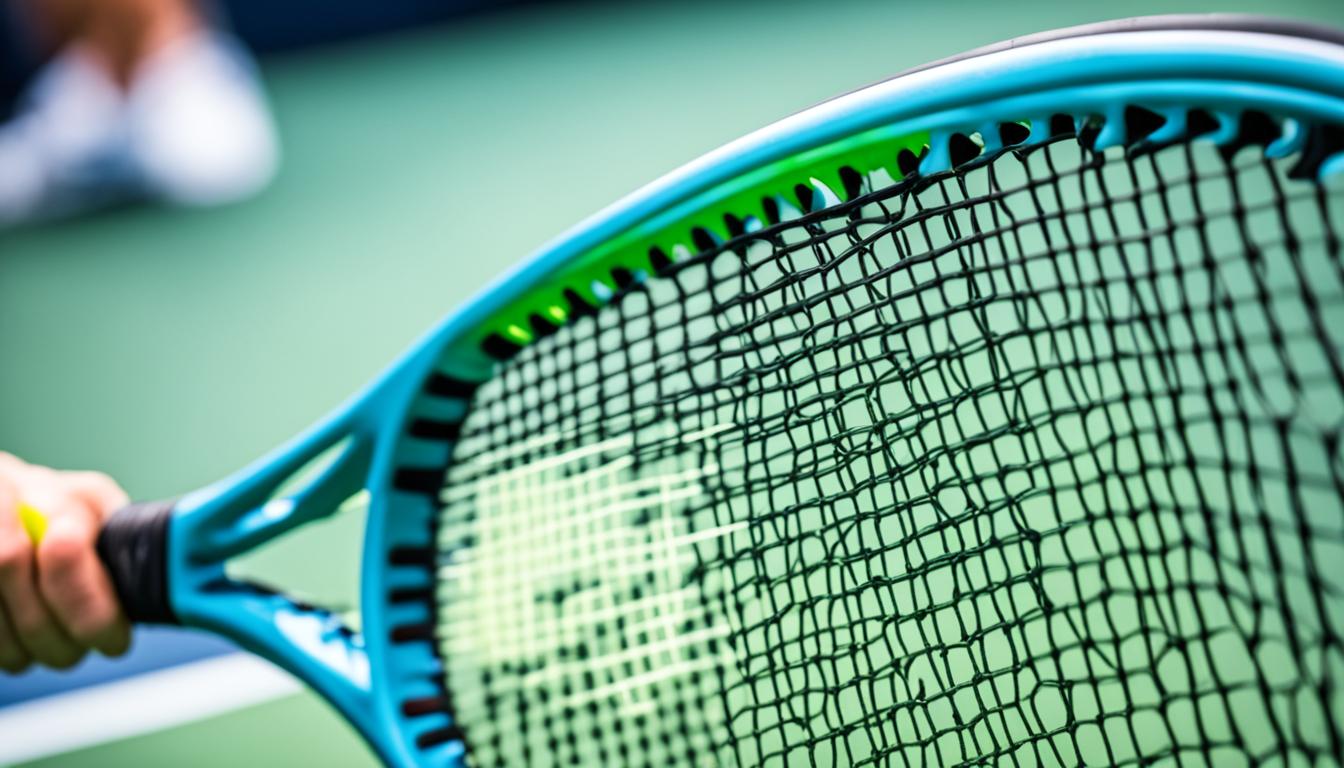Welcome to the world of tennis, where precision meets passion and strategy meets skill. Whether you’re a seasoned player or just starting your tennis journey, there’s always room for improvement in your game. But where do you begin? How do you take your tennis skills to the next level? We’re here to guide you with seven essential tips that will help you master the art of tennis. Are you ready to unlock your potential on the court?
Key Takeaways:
- Understand the fundamentals of tennis to build a strong foundation.
- Equip yourself with the right gear and know the layout of the court.
- Master the different strokes and techniques to enhance your gameplay.
- Develop effective strategies and tactics to outsmart your opponents.
- Build mental toughness and physical fitness to excel on the court.
A Brief History of Tennis
Tennis has a long and storied history, dating back to the 12th century in France. What started as a leisure activity for monks quickly gained popularity, evolving into the beloved sport we know today. Understanding the historical roots of tennis provides valuable insights into its development and evolution over time.
“Tennis is a game of ups and downs, but the history of the sport has always been on the rise.” – David Lloyd
In the 16th century, tennis underwent a significant change with the introduction of rackets and balls. These innovations revolutionized gameplay, giving players more control and power over their shots. As the sport continued to evolve, it spread across Europe, captivating players and spectators alike.

From Grass to Grand Slams
Tennis gained international recognition in the 19th century, with the establishment of the Wimbledon Championships in 1877. This prestigious tournament, played on grass courts, continues to be one of the most iconic events in tennis history.
Over the years, tennis embraced various playing surfaces, such as clay and hard courts, reflecting the changing demands of the game and the preferences of players. Today, the Grand Slam tournaments – Wimbledon, the Australian Open, the French Open, and the US Open – showcase the pinnacle of tennis competition on different surfaces.
The Professional Era and Global Popularity
In 1968, the Open Era began, allowing professional players to compete in major tournaments. This marked a pivotal moment in tennis history, as the sport gained even more worldwide recognition and popularity.
Throughout the decades, legendary players like Billie Jean King, Björn Borg, Chris Evert, Martina Navratilova, Rod Laver, and Serena Williams have elevated the sport with their remarkable skills and competitive spirit. Their contributions have inspired countless aspiring athletes and solidified tennis as a truly global phenomenon.
The Evolution Continues
Tennis continues to evolve with each passing year. Innovations in racket technology, changes in court surfaces, and advancements in training techniques have shaped the modern game. Competitive matches are now characterized by breathtaking rallies, strategic gameplay, and the pursuit of excellence.
As we look to the future, tennis remains a sport that captures our imagination, pushes boundaries, and provides endless excitement for players and fans around the world.
The Basics: Equipment and Court Layout
Before diving into the technical aspects of tennis, it’s important to familiarize ourselves with the basic equipment and court layout. Tennis is played on a rectangular court with a net in the middle, divided into two halves.
Players use rackets to hit a felt-covered rubber ball over the net and into the opponent’s court.
Understanding the dimensions of the court and the characteristics of different types of tennis rackets and balls helps in making informed decisions when selecting your gear.
Let’s take a closer look at the tennis court dimensions and the essential equipment involved:
Tennis Court Dimensions
| Component | Dimension |
|---|---|
| Court Length | 78 feet (23.77 meters) |
| Court Width (Singles) | 27 feet (8.23 meters) |
| Court Width (Doubles) | 36 feet (10.97 meters) |
| Baseline | Between 21 and 21.5 feet (6.4 to 6.55 meters) from the net |
| Singles Sideline | Between 4.5 and 5 feet (1.37 to 1.52 meters) from the calculated court width |
| Net Height (at posts) | 3 feet (0.914 meters) |
| Net Height (at center) | 3 feet 6 inches (1.07 meters) |
Knowing the dimensions of the tennis court allows players to understand the boundaries they need to stay within and how to strategically position themselves during a match. It’s important to note that these dimensions may vary slightly depending on the court surface and specific tournament regulations.
Now, let’s move on to the essential tennis equipment:
Essential Tennis Equipment
- Tennis Racket: Choose a racket that suits your playing style, grip size, and weight preferences. Different rackets offer varying levels of power, control, and maneuverability.
- Tennis Balls: Opt for tennis balls that are appropriate for your skill level and court surface. Beginner or recreational players may prefer softer balls, while professional players typically use pressurized balls for extra speed and bounce.
- Tennis Shoes: Invest in a quality pair of tennis shoes that provide stability, comfort, and traction on different court surfaces. They should be specifically designed for the demands of tennis movements.
- Tennis Apparel: Wear comfortable and breathable clothing that allows freedom of movement and wicks away sweat. Consider wearing a hat and sunglasses for added sun protection.
- Grip Tape or Overgrip: Apply grip tape or overgrip to your racket handle for a secure and comfortable hold.
- Tennis Bag: Carry all your equipment conveniently in a tennis bag that can accommodate your rackets, balls, shoes, apparel, and other accessories.
We’re now equipped with the knowledge of tennis court dimensions and the essential equipment needed to get started. Let’s continue our journey into the technical aspects of tennis and explore how to master the different strokes in the next section.
Mastering the Strokes
One of the keys to success in tennis is mastering the various strokes used to hit the ball. These include the forehand, backhand, volley, and serve. Each stroke requires a unique combination of technique, timing, and footwork to execute effectively.
Focusing on proper form and practicing regularly can refine your strokes and develop consistency and power on the court. Working with a qualified coach or instructor can also provide valuable feedback and guidance to help improve your technique.
Forehand
The forehand stroke is one of the most essential shots in tennis. To execute a forehand, position yourself sideways with your non-dominant shoulder facing the net. Grip the racket firmly and swing it forward with a smooth and controlled motion. The forehand allows you to generate power and accuracy when hitting the ball.
Backhand
The backhand stroke is performed using your non-dominant hand and arm. It is crucial to maintain a strong and steady grip on the racket. Similar to the forehand, position yourself sideways with your non-dominant shoulder facing the net. Swing the racket across your body, keeping your eyes on the ball at all times. Practice timing and footwork to improve your backhand stroke.
Volley
The volley is an effective stroke used when the ball is hit before it bounces on the ground. It requires quick reflexes and good hand-eye coordination. When executing a volley, position yourself near the net and use a wrist-controlled motion to redirect the ball back into your opponent’s court. Practice timing and placement to improve your volley technique.
Serve
The serve is the stroke that begins each point in tennis. It is vital to have a consistent and accurate serve to gain an advantage over your opponent. To execute a serve, stand behind the baseline with your feet shoulder-width apart. Use a fluid motion to toss the ball into the air and strike it with an overhead swing. Apply power and placement to your serve to make it difficult for your opponent to return.
“Mastering the strokes in tennis is a continuous process that requires dedication and practice. By focusing on proper technique and seeking guidance, you can improve your strokes and elevate your game on the court.” – Serena Williams
Regular practice and refining your strokes will enhance your overall game and increase your chances of success in matches. Remember to always work on your footwork, timing, and technique to improve the effectiveness of your strokes. Whether you’re a beginner or an experienced player, consistently striving to master the essential tennis strokes is key to becoming a formidable competitor.
| Stroke | Description |
|---|---|
| Forehand | The forehand stroke is performed using your dominant hand and arm. It is a powerful and versatile shot that allows players to hit the ball with topspin or slice, depending on the desired trajectory. |
| Backhand | The backhand stroke is performed using your non-dominant hand and arm. It requires a different grip and technique compared to the forehand but is crucial in having a well-rounded game. |
| Volley | The volley is a shot that is hit before the ball bounces on the ground. It is typically executed near the net and requires quick reflexes and good hand-eye coordination. |
| Serve | The serve is the shot that begins each point in tennis. It is essential to have a reliable and accurate serve to gain an advantage over your opponent. |
By mastering the essential tennis strokes, you will have a solid foundation to build upon as you continue to develop your skills and advance in the sport. Remember to practice with purpose, seek guidance from experienced players and coaches, and stay committed to improving your technique. With dedication and perseverance, you can elevate your game and achieve success on the tennis court.
Developing Strategies and Tactics
Tennis is not just about hitting the ball over the net; it’s also about outsmarting your opponent. Developing sound strategies and tactics can give you a competitive edge on the court. This includes understanding your opponent’s strengths and weaknesses, adapting your game plan accordingly, and exploiting opportunities during matches.
Playing aggressively at the net, using spin to control the ball’s trajectory, and varying the pace of your shots are just a few examples of effective strategies in tennis.
Understanding Your Opponent
One of the keys to developing effective strategies in tennis is understanding your opponent. Take the time to observe their playing style, identify their strengths, and pinpoint their weaknesses. This knowledge will allow you to tailor your game plan and exploit any vulnerabilities.
Adapting Your Game Plan
No two opponents are the same, and what works against one player may not work against another. It’s important to adapt your game plan based on your opponent’s playing style and the specific dynamics of the match. This versatility will keep your opponent guessing and give you the upper hand.
Exploiting Opportunities
In every match, there are moments when your opponent may be vulnerable. It could be a weak return, poor footwork, or a lapse in concentration. These are the opportunities you need to capitalize on. By recognizing these moments and adjusting your tactics accordingly, you can gain an advantage and turn the tide of the match in your favor.

Remember, tennis is a dynamic and ever-evolving sport, and what works in one match may not work in another. Stay adaptable, keep refining your strategies, and always be open to learning new tactics. With time and practice, you’ll develop a repertoire of strategies that will give you a competitive edge on the court.
| Effective Tennis Strategies | Description |
|---|---|
| Aggressive Net Play | Rushing the net and putting pressure on your opponent can force them into making errors. |
| Ball Control with Spin | Using topspin, backspin, and slice to control the ball’s trajectory and make it more difficult for your opponent to return. |
| Varying Shot Pace | Changing the speed of your shots to keep your opponent off balance and prevent them from getting into a rhythm. |
| Targeting Weaknesses | Identifying your opponent’s weaknesses and deliberately targeting those areas to gain an advantage. |
| Creating Angles | Hitting shots that pull your opponent out of position and open up the court for winners. |
| Mixing Up Serve Placement | Varying your serve placement to keep your opponent guessing and make it harder for them to anticipate your shots. |
Mental Toughness and Fitness
In addition to mastering the technical skills and strategic insights of tennis, mental toughness and fitness are crucial aspects of the game. Whether you’re playing a long and grueling match or facing challenging opponents, your mental resilience and physical abilities can greatly impact your performance on the court.
The Importance of Mental Toughness
Tennis is not just a physical game but also a mentally challenging sport. The ups and downs of a match can test your mental fortitude, and staying focused and composed under pressure is key to success. Developing mental toughness allows you to handle adversity, maintain concentration, and make quick and confident decisions during high-stakes moments.
One way to strengthen your mental toughness is through visualization and positive self-talk. Visualize yourself performing at your best and achieving your goals. Use affirmations to reinforce your confidence and belief in your abilities. These techniques can help you maintain a positive mindset and overcome doubts and distractions on the court.
Enhancing Physical Fitness
Physical fitness is essential for excelling in tennis. Matches can be physically demanding, requiring agility, speed, endurance, and strength. Incorporating specific fitness training into your regimen can enhance your overall performance and help you outlast your opponents.
Focusing on cardiovascular exercises like running or cycling improves endurance, while strength training exercises like weightlifting or resistance training build muscular strength and power. Flexibility exercises such as yoga or stretching routines enhance agility and prevent injuries. Incorporating these various forms of exercise into your routine can improve your overall fitness and enhance your on-court performance.
Rest and Recovery
Rest and recovery are also critical for maintaining peak performance and preventing injuries. Overtraining can lead to fatigue, decreased performance, and an increased risk of injury. Make sure to incorporate rest days into your training schedule, allowing your body time to recover and repair itself.
Additionally, incorporating relaxation techniques into your routine can help manage stress and improve mental well-being. Techniques such as deep breathing, meditation, and mindfulness can help you stay calm and focused during matches and relieve tension and anxiety.
| Benefits of Mental Toughness and Fitness in Tennis |
|---|
|
By prioritizing mental toughness and physical fitness in your tennis training, you can significantly elevate your game. Incorporate exercises, techniques, and strategies that enhance your mental resilience and physical abilities to perform at your best and achieve success on the court.
Tennis: Endless Opportunities for Growth and Enjoyment
Tennis is a sport that offers endless opportunities for growth, improvement, and enjoyment. Whether you’re a casual player looking to have fun with friends or a competitive athlete striving for greatness, there’s always something new to learn and explore in tennis. By mastering the fundamentals, honing your skills, and adopting a strategic mindset, you can take your game to new heights and experience the thrill of competition like never before.
Playing tennis provides a unique avenue for personal growth. As you engage in the sport, you challenge yourself physically and mentally, pushing boundaries and surpassing limitations. Each match, practice, and training session presents an opportunity to develop key qualities such as perseverance, discipline, and resilience. Tennis teaches individuals how to handle pressure and adapt to changing circumstances, skills that extend far beyond the court.
Beyond personal growth, tennis also offers immense enjoyment. The thrill of hitting a perfect shot, the satisfaction of winning a hard-fought match, and the camaraderie built with fellow players can bring immense happiness. Whether you are playing in a friendly match or participating in a competitive tournament, tennis brings people together, fostering a sense of community and shared passion.
To illustrate the growth and enjoyment that tennis provides, let’s take a look at some of the key aspects of the sport:
Mind and Body Balance
In tennis, success relies on the harmonious balance between the mind and body. From a physical standpoint, the sport improves endurance, strength, agility, and coordination. Tennis requires quick reflexes, explosive power, and the ability to move gracefully on the court. Regular play and practice contribute to overall fitness and well-being.
Meanwhile, tennis is also a mentally stimulating sport. As you strategize, problem-solve, and make split-second decisions, you enhance your cognitive skills. The sport challenges you to concentrate under pressure, stay focused throughout matches, and stay mentally tough in the face of adversity.
Constant Learning and Improvement
Tennis is a sport that encourages continuous learning and improvement. From refining your technique to exploring new strategies, there is always something to discover on the court. Working with a coach or joining a tennis training program can provide valuable guidance, helping you fine-tune your skills and elevate your game.
Competition and Achievement
For those who thrive on competition, tennis offers the perfect platform to showcase your skills. Competing in tournaments and matches allows you to test yourself against formidable opponents, challenging you to continually raise the bar. The drive to succeed, set goals, and celebrate achievements adds an exciting dimension to the sport.
Physical and Mental Well-being
Engaging in regular tennis play not only improves physical fitness but also contributes to mental well-being. The endorphins released during physical activity promote a positive mood and reduce stress levels. Tennis can be a form of therapy, providing an escape from daily pressures and allowing you to focus on the present moment.
A Sport for All Ages
Tennis is a sport that spans generations. Whether you’re a child picking up a racket for the first time or an adult rediscovering the game, tennis is accessible to people of all ages. The sport offers opportunities for family bonding, social connections, and lifelong friendships.
Inspiring Role Models
Tennis boasts a rich history of iconic players who have inspired generations of fans. From legends like Serena Williams and Roger Federer to rising stars like Naomi Osaka and Coco Gauff, these athletes epitomize the fierce determination, sportsmanship, and resilience that define the sport. Their stories and achievements serve as powerful motivators for aspiring players, fueling the desire for growth and improvement.
Whether you’re seeking personal growth, enjoyment, competition, or a combination of these, tennis provides a fulfilling and enriching experience. So, pick up a racket, step onto the court, and embark on a journey of growth, improvement, and undying love for the game.

Improve Your Net Game with Proven Tennis Tips
The net game has always played a vital role in the game of tennis, and even in modern tennis strategies, it remains a key component. Enhancing your net game can greatly improve the versatility and effectiveness of your shots. Here are some proven tennis tips to help you elevate your net play:
- Choose the right grip: Having the correct grip is crucial for executing successful net shots. Experiment with different grips to find the one that offers the best control and power.
- Develop grip strength: An essential aspect of excelling at the net is having a strong grip. Strengthen your grip by incorporating exercises such as squeezing a tennis ball or using grip strengtheners.
- Utilize your non-dominant hand: Use your non-dominant hand for support when at the net. This will help stabilize your shots and provide better control during volley exchanges.
- Focus on the ball: Keep your eyes on the ball at all times when playing at the net. This will enable you to anticipate your opponent’s shots and react quickly.
- Move your body weight forward: Shift your body weight forward as you approach the net. This will help you maintain a solid position and generate more power in your shots.
Remember, practice makes perfect, and one valuable practice technique is to hit against a wall. Utilize the wall to improve your net game skills, honing your reaction time, timing, and shot placement.
“Improving your net game can give you a significant advantage on the tennis court. By implementing these tips and investing time in focused practice, you’ll become a formidable opponent at the net.”
Now let’s dive into a comprehensive table that compares different net game strategies:
| Net Game Strategies | Description | Advantages |
|---|---|---|
| Volley | Hitting the ball in the air before it bounces | – Allows for quick reaction time – Limits the opponent’s response options |
| Overhead Smash | A powerful shot executed when the ball is high above the net | – Difficult for opponents to return – Puts pressure on the opponent |
| Drop Shot | A soft shot that barely clears the net and dies upon landing | – Requires finesse and accuracy – Forces opponents to cover more court |
| Half-Volley | Hitting the ball immediately after it bounces | – Provides better control and placement – Allows for faster shots |
By incorporating these strategies into your game, you’ll have a well-rounded net game and keep your opponents on their toes.
8 Fundamental Singles Strategies for Winning in Tennis
Singles strategy is essential for success in tennis. To achieve victory on the court, it is crucial to implement the right set of strategies. Here are eight fundamental singles strategies that lay the foundation for any tactical game plan:
- Out-Rallying the Opponent: Consistently hitting deep, powerful shots to keep your opponent on the defensive and create opportunities for winning points.
- Playing Aggressively: Taking control of the match by dictating the pace, being assertive with your shots, and putting pressure on your opponent.
- Playing to Your Strengths: Leveraging your own abilities and skills to exploit your opponent’s weaknesses and gain an advantage.
- Hitting to the Opponent’s Weaknesses: Identifying and targeting your opponent’s areas of vulnerability to force errors and create scoring opportunities.
- Attacking the Net: Utilizing well-timed and well-executed volleys to take control of the net and put your opponent on the defensive.
- Bringing the Opponent to the Net: Using tactical shots and angles to draw your opponent to the net, where they may be less comfortable and more prone to mistakes.
- Using Variety to Create Mistakes or Short Balls: Incorporating a mix of shots, spins, and pace variations to disrupt your opponent’s rhythm, forcing errors or setting up favorable opportunities.
- Opening the Court: Using angles, cross-court shots, and smart positioning to create open spaces on the court, making it more difficult for your opponent to defend.
By combining these fundamental strategies, you can develop a comprehensive singles game plan that maximizes your chances of winning matches and elevates your performance to an elite level.
Now, let’s take a closer look at the effectiveness of implementing these strategies in singles play:
The Power of Out-Rallying the Opponent
“Out-rallying my opponent has been a game-changer in my singles matches. By consistently hitting deep and powerful shots, I keep my opponent on the run and force them into defensive positions. This allows me to gain control of the rally and set up winning shots.”
By implementing a well-thought-out singles strategy, you can become a formidable force on the tennis court, taking your game to new heights and achieving success against any opponent.
| Strategy | Description |
|---|---|
| Out-Rallying the Opponent | Hitting deep, powerful shots to keep the opponent on the defensive and create opportunities to win points. |
| Playing Aggressively | Taking control of the match by dictating the pace, being assertive with shots, and putting pressure on the opponent. |
| Playing to Your Strengths | Leveraging your abilities and skills to exploit the opponent’s weaknesses and gain an advantage. |
| Hitting to the Opponent’s Weaknesses | Identifying and targeting the opponent’s areas of vulnerability to force errors and create scoring opportunities. |
| Attacking the Net | Utilizing well-timed and well-executed volleys to take control of the net and put the opponent on the defensive. |
| Bringing the Opponent to the Net | Using tactical shots and angles to draw the opponent to the net, where they may be less comfortable and more prone to mistakes. |
| Using Variety to Create Mistakes or Short Balls | Incorporating a mix of shots, spins, and pace variations to disrupt the opponent’s rhythm, forcing errors or setting up favorable opportunities. |
| Opening the Court | Using angles, cross-court shots, and smart positioning to create open spaces on the court, making it more difficult for the opponent to defend. |
Why Singles Strategy Matters in Tennis
Having a clear strategy in singles play is crucial for success. Without a strategy, players may fall into a pattern of random shot combinations and reactive gameplay. Understanding and implementing singles strategies can maximize your potential on the court. These strategies provide a GPS-like guidance system, keeping you on the right track and increasing your chances of winning matches.
When it comes to singles strategy, it’s not just about hitting the ball; it’s about making calculated decisions to outplay your opponent. By developing a thoughtful approach to your game, you can anticipate your opponent’s responses and adjust your tactics accordingly. This allows you to control the tempo of the match and exploit your strengths while targeting your opponent’s weaknesses.
One important aspect of singles strategy is shot selection. By carefully choosing the type and placement of your shots, you can force your opponent into difficult positions and create opportunities for yourself. This may involve using a mix of powerful shots to push your opponent back, drop shots to catch them off guard, or slices to disrupt their rhythm.
“Singles strategy is like a chess game, where every move counts. It’s about finding the right balance between offense and defense, and being proactive rather than reactive.”
Another key element of singles strategy is court positioning. By strategically positioning yourself on the court, you can control the flow of the game and put pressure on your opponent. This may involve moving closer to the net to cut off angles and force your opponent to hit difficult passing shots, or staying further back to defend against powerful shots.
Furthermore, singles strategy is not just about the physical aspects of the game; it also involves mental strength and decision-making. By staying focused, composed, and adaptable, you can make sound judgments under pressure and make the most of every opportunity that arises.
Implementing a solid singles strategy can make a significant difference in your performance and results on the court. It allows you to play with purpose, purpose and intention, rather than relying solely on your natural abilities. It also provides a framework for continuous improvement, as you can evaluate the effectiveness of your strategies and make adjustments as needed.

When it comes to tennis, honing your skills and physical abilities are important, but developing a strategic mindset is equally vital. By focusing on singles strategy, you can elevate your game and increase your chances of success. So, next time you step onto the court, don’t just rely on instinct – have a clear plan and unleash the power of strategy!
Practice Drills for Improving Specific Tennis Strategies
To improve your tennis strategies, we recommend incorporating various practice drills into your training regimen. These drills are designed to target specific areas of your game and enhance your strategic gameplay. By dedicating time to these drills, you can sharpen your skills and take your tennis performance to the next level.
Rallying with a Partner
One effective drill for improving consistency and shot placement is rallying with a partner. This drill allows you to focus on maintaining a steady rhythm and controlling the ball during longer rallies. Start by rallying from the baseline and gradually increase the intensity and pace of your shots. This drill not only helps you work on your technique but also enhances your communication and teamwork skills on the court.
“No Winner” Points
Another valuable drill to incorporate into your practice routine is playing “no winner” points. In these points, the objective is to focus on safe and controlled shots rather than going for winners. This drill helps you develop patience, shot selection, and the ability to construct points strategically. By emphasizing consistency and shot placement over power, you can improve your decision-making skills during matches.
Wall Practice for Net Game Skills
If you’re looking to enhance your net game skills, practicing against a wall can be highly beneficial. This drill allows you to simulate the angles and quick reflexes required for successful net play. Stand close to the wall and hit volleys, overheads, and half-volleys, focusing on technique and footwork. This drill helps improve your reaction time, timing, and overall net game proficiency.
Playing Points with Specific Targets
An excellent drill for targeting weaknesses and creating variety in your game is playing points with specific targets. Set up targets on the court, such as corner areas or specific zones, and aim to hit the ball into these targets during points. This drill forces you to be intentional with your shot selection, develop better court awareness, and learn how to exploit your opponent’s weaknesses. It also encourages you to experiment with different strokes and strategies, adding versatility to your game.
Incorporating these practice drills into your training routine will help you improve your tennis strategies and elevate your overall gameplay. Remember to practice consistently, focus on technique, and embrace the learning process. With dedication and persistence, you can enhance your strategic thinking on the court and achieve greater success in your matches.
We’ve Got You Covered
At our training facility, we offer comprehensive tennis programs that include specialized practice drills to enhance your strategies and improve your game. Our experienced coaches provide personalized instruction to help you develop a winning mindset and elevate your performance on the court. Join us today and unlock your full potential as a tennis player.
Conclusion
Tennis is a sport that offers endless opportunities for growth, improvement, and enjoyment. Whether you’re a casual player or a competitive athlete, implementing these essential tips can help you improve your overall tennis skills and elevate your performance on the court.
By mastering the fundamentals of tennis, such as understanding the equipment and court layout, developing strategic insights, and practicing specific techniques, you can take your game to new heights. It’s important to focus on mastering the various strokes, developing strategies and tactics, and focusing on mental toughness and fitness.
So grab your racket, hit the court, and embark on an exhilarating journey of self-discovery and achievement through the beautiful game of tennis. Whether you’re looking for personal growth or aiming for success in competitions, with dedication and practice, your tennis game can continuously improve. Tennis is a lifelong sport that offers not only physical benefits but also mental and emotional stimulation, making it a rewarding endeavor for all who participate.
FAQ
What is the history of tennis?
Tennis has a long and storied history, dating back to the 12th century in France. Over the centuries, the game evolved with the introduction of rackets and balls in the 16th century. It gained popularity across Europe and eventually became a beloved sport worldwide.
What is the basic equipment and court layout in tennis?
Tennis is played on a rectangular court with a net in the middle, divided into two halves. Players use rackets to hit a felt-covered rubber ball over the net and into the opponent’s court. Understanding the dimensions of the court and the characteristics of different types of tennis rackets and balls helps in making informed decisions when selecting your gear.
What are the various strokes used in tennis?
The various strokes used in tennis include the forehand, backhand, volley, and serve. Each stroke requires a unique combination of technique, timing, and footwork to execute effectively.
How can I develop strategies and tactics in tennis?
Developing strategies and tactics in tennis involves understanding your opponent’s strengths and weaknesses, adapting your game plan accordingly, and exploiting opportunities during matches. Playing aggressively at the net, using spin to control the ball’s trajectory, and varying the pace of your shots are just a few examples of effective strategies in tennis.
What is the role of mental toughness and fitness in tennis?
Tennis matches can be physically demanding, requiring strength, agility, and endurance. Mental resilience is equally important, as tennis can be a mentally challenging sport. Staying focused, managing pressure, and maintaining a positive mindset are key to performing at your best.
How can I improve my net game in tennis?
To improve your net game in tennis, you can focus on choosing the right grip, grip strength, utilizing your non-dominant hand for support, focusing on the ball, and moving your body weight forward. Practicing against a wall can also help improve your net game skills.
What are the fundamental singles strategies in tennis?
The fundamental singles strategies in tennis include out-rallying the opponent, playing aggressively, playing to your strengths, hitting to the opponent’s weaknesses, attacking the net, bringing the opponent to the net, using variety to create mistakes or short balls, and opening the court.
Why is singles strategy important in tennis?
Having a clear singles strategy in tennis is crucial for success. Without a strategy, players may fall into a pattern of random shot combinations and reactive gameplay. Understanding and implementing singles strategies can maximize your potential on the court.
What are some practice drills for improving tennis strategies?
Practice drills for improving tennis strategies include rallying with a partner to improve consistency, playing “no winner” points to focus on safe and controlled shots, practicing against a wall to enhance net game skills, and playing points with specific targets to work on attacking weaknesses or creating variety.
How can I improve my overall tennis skills?
To improve your overall tennis skills, it is important to master the fundamentals, develop strategic insights, and practice specific techniques. By incorporating these essential tips into your training, you can elevate your game and experience the thrill of competition.






